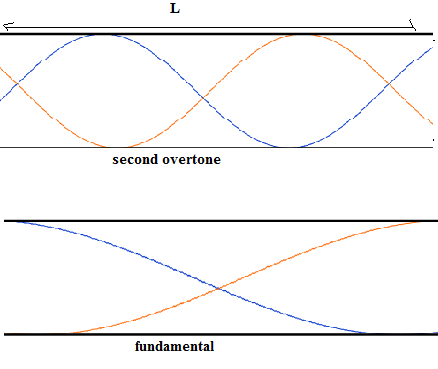
The speed of sound in air is 333m/s. The fundamental frequency of the open pipe is 333Hz. The second overtone of the open organ pipe can be produced with a pipe of length:
A. 0.5 m
B. 1.0 m
C. 1.5 m
D. 2.0 m
Answer
579.6k+ views
Hint: Condition for production of standing waves is to be used here. Second overtone in an open pipe corresponds to a frequency that is around thrice the fundamental frequency. There are around three peaks of a wave that fit into the pipe in such a case.
Formula used:
The formula for the length of the pipe is:
$L = \dfrac{nv}{2 \nu}$
Where n= 1 for fundamental frequency and n= 3 for second overtone.
Complete answer:

In an open pipe, for fundamental frequency, to produce standing wave we require that the length of the pipe should be twice the wavelength of the fundamental mode or:
$\dfrac{\lambda}{2} = L$
The relation with frequency is:
$L = \dfrac{v}{2 \nu}$
where v is the velocity of sound in our case.
This is so because frequency and wavelength are related as:
$v=\nu \lambda$
For the second overtone, the wavelength is thrice of fundamental wavelength. Therefore, we replace $\lambda$ by $3 \times \lambda$
Keeping this in the formula for length and keeping the velocity of sound 333 m/s (given) in place of v:
$L = \dfrac{999 m/s}{2 \times 333 Hz}$
$L = \dfrac{ 3}{2}$m
L= 1.5 m
Therefore, the correct option is 1.5 m.
So, the correct answer is “Option C”.
Additional Information:
Standing waves result as a superposition of incoming waves and outgoing waves such that their phases become opposite. The best method to remember standing wave condition is to think of a rope with its one end tied. When we create a wave in such rope, at the tied end the wave reverses back and comes to us. Therefore, the entire rope seems to be making simple up and down motion.
Note:
The unit of frequency Hz is also $s^{-1}$ that is how we got cancellation of this in numerator and denominator and only m remained. Also the frequency and wavelength relation might get confusing. To sort it out, refer to the diagram; 3 times the new wavelength is twice the pipe length.
Formula used:
The formula for the length of the pipe is:
$L = \dfrac{nv}{2 \nu}$
Where n= 1 for fundamental frequency and n= 3 for second overtone.
Complete answer:

In an open pipe, for fundamental frequency, to produce standing wave we require that the length of the pipe should be twice the wavelength of the fundamental mode or:
$\dfrac{\lambda}{2} = L$
The relation with frequency is:
$L = \dfrac{v}{2 \nu}$
where v is the velocity of sound in our case.
This is so because frequency and wavelength are related as:
$v=\nu \lambda$
For the second overtone, the wavelength is thrice of fundamental wavelength. Therefore, we replace $\lambda$ by $3 \times \lambda$
Keeping this in the formula for length and keeping the velocity of sound 333 m/s (given) in place of v:
$L = \dfrac{999 m/s}{2 \times 333 Hz}$
$L = \dfrac{ 3}{2}$m
L= 1.5 m
Therefore, the correct option is 1.5 m.
So, the correct answer is “Option C”.
Additional Information:
Standing waves result as a superposition of incoming waves and outgoing waves such that their phases become opposite. The best method to remember standing wave condition is to think of a rope with its one end tied. When we create a wave in such rope, at the tied end the wave reverses back and comes to us. Therefore, the entire rope seems to be making simple up and down motion.
Note:
The unit of frequency Hz is also $s^{-1}$ that is how we got cancellation of this in numerator and denominator and only m remained. Also the frequency and wavelength relation might get confusing. To sort it out, refer to the diagram; 3 times the new wavelength is twice the pipe length.
Recently Updated Pages
Why are manures considered better than fertilizers class 11 biology CBSE

Find the coordinates of the midpoint of the line segment class 11 maths CBSE

Distinguish between static friction limiting friction class 11 physics CBSE

The Chairman of the constituent Assembly was A Jawaharlal class 11 social science CBSE

The first National Commission on Labour NCL submitted class 11 social science CBSE

Number of all subshell of n + l 7 is A 4 B 5 C 6 D class 11 chemistry CBSE

Trending doubts
10 examples of friction in our daily life

One Metric ton is equal to kg A 10000 B 1000 C 100 class 11 physics CBSE

Difference Between Prokaryotic Cells and Eukaryotic Cells

1 Quintal is equal to a 110 kg b 10 kg c 100kg d 1000 class 11 physics CBSE

State the laws of reflection of light

Explain zero factorial class 11 maths CBSE




